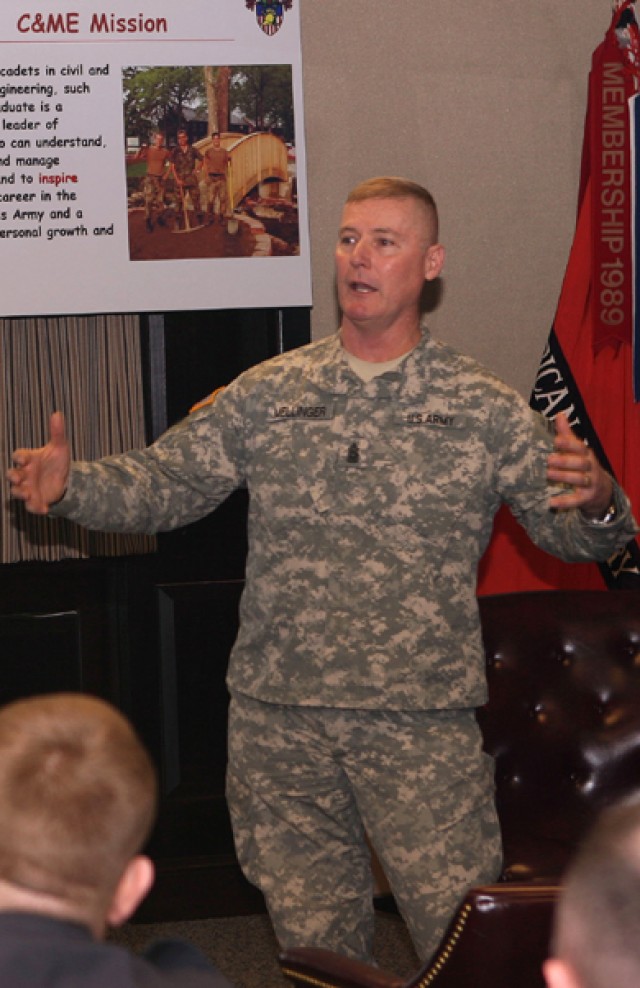If U.S. Military Academy cadet-scientists are successful, combat troops soon could have smarter robots, safer vehicles and better roadside bomb detection equipment while wounded Soldiers could get a better false foot.
For now, the inventions being tweaked in West Point laboratories are for brain exercising, bragging rights and hefty prizes. But in the future, these cadets might take their own creations to battle.
"This is really motivating," Senior Tom Anderson said about his team's improved Humvee gunner's hatch invention. "It's not just another school project. It could make a difference for us and for Soldiers."
Nine teams of cadets are working to improve the Army's equipment after being challenged by MIT to participate in the Soldier Design Competition.
Since 2004, MIT has hosted a competition to solve some of the Army's design questions. West Point has been invited to participate each year since 2005, Col. Russ Lachance, West Point chemical engineering professor and liaison officer for the competition, said. The competition is confined to teams from the two schools.
For the competition, MIT solicits equipment questions from the Army. This year, competitors were asked to work on equipment that analyzes shock and sound waves and to develop ways for equipment to absorb ultraviolet and infrared rays, autonomous robots that can carry wireless sensors, a portable navigation tool, a pest-repellent uniform, analyze signal strengths or come up with solutions to other problems.
The cadet teams invented a bionic foot, two autonomous robots with wireless sensors, a AA battery recharger that straps to a Soldier's boot and uses energy generated from walking to recharge the batteries, a system to collect and store panoramic surveillance photos, a roadside bomb destruction system and Anderson's team's gunner's hatch.
The inventions were presented Jan. 9 to Command Sgt. Maj. Jeffery Mellinger, senior noncommissioned officer of Army Materiel Command, who has been a past Soldier Design Competition judge. Also, Mellinger, who has been on active duty for 37 years and was the senior noncommissioned officer of Multi-National Force-Iraq from 2004-07, is one of the Army's foremost subject matter experts on currently fielded equipment and what Soldiers need.
Along with briefing cadets about what AMC does to help them understand the vital role of good logistics, Mellinger offered advice about how to present the inventions to the competition's judges and how to tweak them to better serve Soldiers' needs.
"I think it's fascinating to see how cadets can take a needs statement and watch how they go about solving it," Mellinger said after hearing about the inventions. "There are different solutions to the same problem. ... Watching how they analyze the statement and seeing where they go and, based on the feedback, what kind of adjustments they make if any, it's really fascinating."
Mellinger said he also enjoys the lessons in leadership the competition gives the cadets, who soon will be commissioned as second lieutenants. He called the competition a "high-tech leadership reaction course" and said the competition teaches them about critical thinking and analysis.
Plus, some of the competition's inventions are adopted by the Army and save Soldiers' lives. A rope design from the 2005 competition replaced the knotted rope Rangers were using to descend on missions, Mellinger said. Another invention being considered by the Army is a cooling helmet, Senior Nathaniel Clark said.
"I thought, 'If they could do that, why not me,'" Clark said about hoping his team's gunner's hatch is considered by the Army.
His team's hatch design has several variations. One includes a sliding canopy while others use several panel pieces that can be removed and customized to mission requirements.
Mellinger cautioned the team about making a one-size-fits-all model and encouraged them to continue to consider how to protect gunners.
"It was great to get feedback from people who understand all aspects of this and could tell us what we did right or what we should fix or whether it's something someone already thought of," Senior Briana Stremick, who also is on the gunner's hatch team, said.
Cadets will present their inventions at the competition in April at MIT. Last year, West Point teams took the Top 3 spots in the competition and seven prizes over all.
In 2007, first and second place went to West Point teams as well as $8,000 in prizes. West Point teams took fifth and sixth place at the competition the year before and received $4,000 in prizes.


Social Sharing